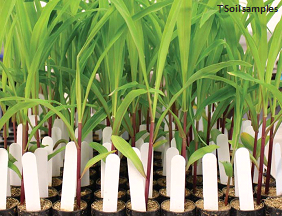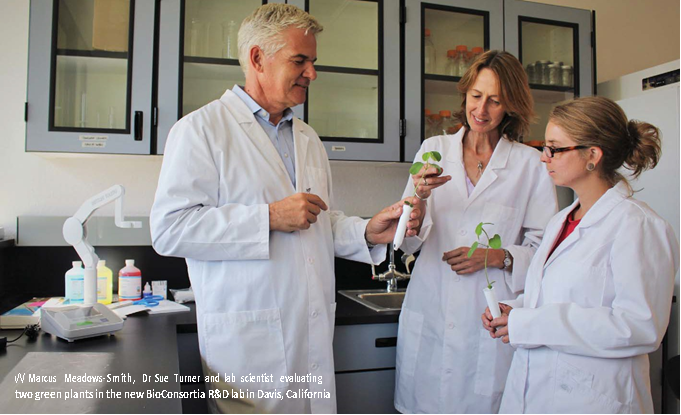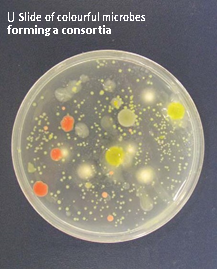Biological products in agriculture: changing the game

When we talk about the ‘movers and shakers’ of the chemical industry, giant companies come to mind. But sometimes one visionary individual can alter the landscape for years to come. Speciality Chemicals Magazine talks to Marcus Meadows-Smith.
He has come to be known as a pioneer and game changer in the Biopesticides space. In 2008, Meadows-Smith moved from his position as executive vice president at Chemtura Corp – where he was responsible for US$1.9 billion in agricultural, plastic additives, water treatment and consumer businesses – and chose instead to be the CEO of a small, US$10 million biopesticides business, AgraQuest. He did so at a time when the business was losing money, was financially stressed and when biopesticides were still regarded as mostly ‘snake oil’ and for the tiny organic segment only. But the risk paid off.
Meadows-Smith was the catalyst, leading his team to marry biopesticides with chemical pesticides, propelling biopesticides (and biological products generally) into an integral part of conventional agriculture, growing at 15% to 20%/year.

In 2008, AgraQuest was in financial distress with flat revenue. Its strategy unclear, the company was a niche player with a focus on organic production operating in a market that had a poor perception of biopesticides. But Meadows-Smith saw the positives: the company employed expert people with great passion, it had a potentially successful product, ‘Serenade’, and intellectual property comprising strains and natural product chemistry.
Within the first three months, Meadows-Smith and the AgraQuest team had re-evaluated the company’s strategy to focus on value creation, not on sales or products. They wanted it to become a ‘go-to’ R&D partner, to focus on mainstream agriculture and partner with large agrichemical companies.
“AgraQuest was innovative in the space and, although it was really struggling, we saw certain market drivers that could make it a success. We thought, let’s not just chase the organic market but let’s combine the biologicals with chemistry to get better efficacy and better yield result,” he says “A deal with the devil” Drawing upon his strong relations in the chemical industry, he signed the first major deal between a big agrichemical company, BASF, and a biopesticides company, in which BASF received exclusive distribution rights to Serenade Biofungicide outside of the US. The deal was remarkable: at the time, biopesticides companies and agricultural companies viewed each other with great suspicion. No one thought synthetics could be complimented with biologics and many thought the agreement was a “deal with the devil”. But it transformed the industry and, today, these companies actively seek each other out for collaboration.
How did he get the giants on board? “The data persuaded them,” Meadows-Smith says. “We designed spray programmes where we sprayed fungicides on some crops and biologicals on others. We proved that the biologicals were just as effective as the chemistry and also increased yield. Companies were also interested because overuse of the same chemical class was causing resistance in crops; this doesn’t happen with biologicals.”
The company went on to sign an R&D deal with Monsanto and then more with Pfizer, Bayer and DuPont. After only four and a half years at the helm, he led the sale of AgraQuest to Bayer CropScience for US$425 million, plus performance payments. Bayer asked him to come on board as Head of Biologics, during which time he was responsible for the successful integration of AgraQuest into the company.

BioConsortia
After Bayer, not satisfied with retirement or past successes, he began to research biotechnology companies, seeking the one innovative biological technology that would have the most impact.
“The environment, science and farming are my true passions,” he says. “I wanted to find and build technology that would increase crop yields – feed more people in a healthy, affordable and sustainable way – and reduce the amount of chemical load in the environment.” He investigated over 30 technologies from as many different companies and settled on one in an unlikely place: Auckland, New Zealand. He was hired as the CEO (by the private equity investors), moved its headquarters to Davis, California, and started building a talented team of 35 agronomists and biological scientists. He began using the company’s revolutionary technology to develop new microbiological products with higher levels of efficacy and consistency. The result is a pipeline of beneficial microbial products that can help plants overcome biotic (pests and diseases) and abiotic (drought, climate and environmental) stresses, and improve the plant health and crop yields. The company is BioConsortia.

“BioConsortia had a totally different approach to microbes. It had an R&D platform that allowed the plant to decide what was useful, not the scientist,” he explains.
The company focuses on identifying small teams of microbes – the best ‘microbial consortia’ – that influence the plant’s phenotype. These consortia help it resist attack by pests and diseases, or overcome adverse growing conditions, or better utilise the soil nutrients and applied fertilisers, to deliver healthier, higher yielding plants.
Microbes naturally colonise plants, providing beneficial, harmful or neutral interactions. The trick is finding the beneficial ones. Genomics and microbiome analysis are two methods employed by BioConsortia to help identify the best team. “DNA sequencing is now cheap enough to allow us to analyse the plant microbiome and predict microbes that are associated with high-performing plants,” Meadows- Smith says.
“Consumer reaction has been very positive,” he adds. “They don’t just associate bacteria with disease, but think of probiotics, yoghurt, beer, wine or cheese – these foods are fermented using microbes and have beneficial effects. We do the same thing with crops, so that the plants are not genetically modified but natural and grown with a healthy microbiome, essential for growing organic and conventional food.”

Precision potential
Biopesticides have been on the scene for over 30 years, but always confined to niche markets until recent years. The sustainable or ‘low chemical’ agricultural market is now at around US$5 billion and expected to reach US$17 billion by 2025, according to consultancy DunhamTrimmer, as industry strives to feed nine billion people sustainably. The market potential is huge.
“Over the next 10-15 years, biopesticides and biostimulants will be tools we increasingly use as we better understand their mode of action, plant and environmental interaction,” says Meadows-Smith. “While we’re not looking to replace chemical pesticides at BioConsortia, we are focused on increasing yields. As the climate changes and we experience more extreme weather events – and as we look to grow more food on fewer acres of land – microbes will be an invaluable part of our toolkit.”
The opportunities in biotechnology have always fascinated Meadows- Smith, who graduated from the UK’s University of Birmingham with a degree in biology and genetics. “The public often views agrichemical companies with scepticism, but most people go into this industry because they care about the environment and want a career that allows them to trample through fields in their boots. The majority are working together to find sustainable, environmentally-friendly solutions for people and the planet.”
And the key to transforming a new idea into a successful business? “People,” he says. “Get your strategy right and build a great team. I have been so lucky to work with great teams at Chemtura/Uniroyal, AgraQuest, Bayer and now BioConsortia.”
Meadows-Smith is also on the board of another biological start-up, Crop Enhancement, a company with an innovative biophysical product for enhancing plant performance. But he can often be found on a tractor at his vineyard in California. Great Bear Vineyards produces premium wines from sustainably grown grapes using some of the technology he has helped develop.
